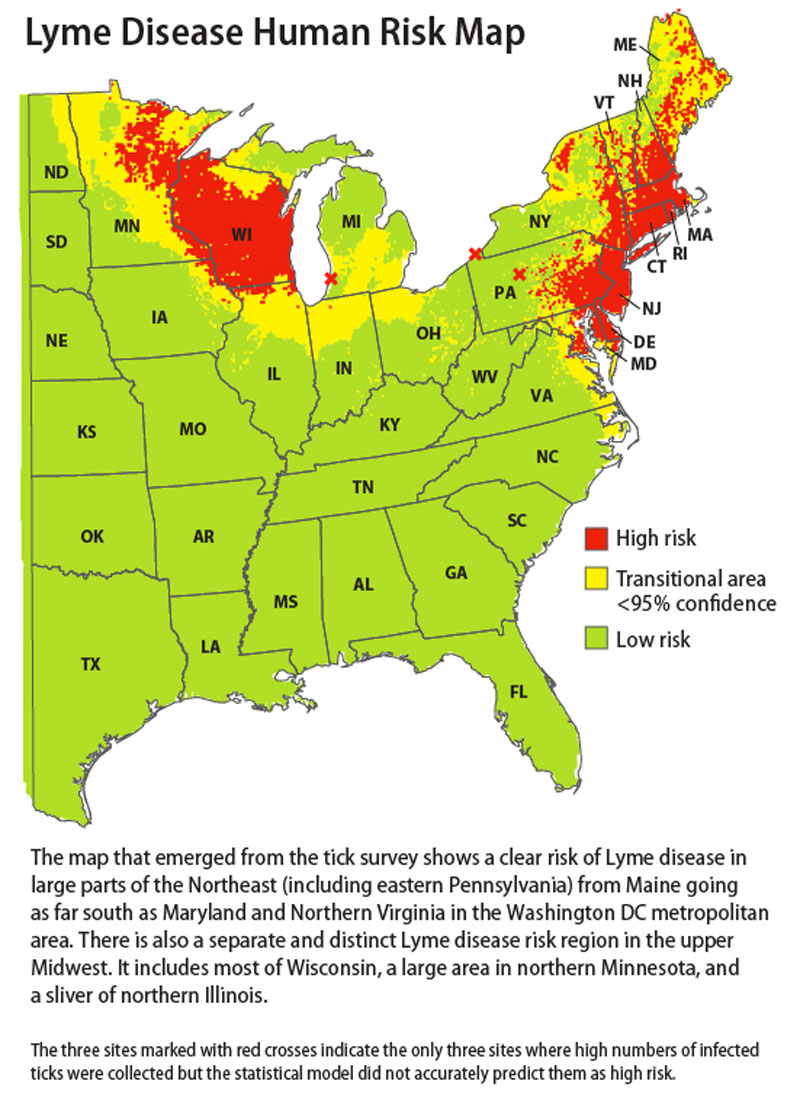Lyme Disease High-Risk Areas Revealed in New Map

An extensive field study has identified areas of the U.S. where people have the highest risk of contracting Lyme disease, according to the Centers for Disease Controland Prevention(CDC).
The study found that high infection risk is mainly confined to the Northeast, Mid-Atlantic and Upper Midwest regions of the country.
Lyme disease is one of the most rapidly emerging infectious diseases in North America, and there were nearly 30,000 confirmed cases of Lyme disease in the U.S. in 2009, according to the CDC. People are infected with bacteria that cause Lyme disease when they are bitten by an infected deer tick.
"A better understanding of where Lyme disease is likely to be endemic is a significant factor in improving prevention, diagnosis and treatment," study researcher Maria A. Diuk-Wasser, of the Yale School of Public Health, said in a statement. "People need to know where to take precautions to avoid tick bites."
Helping Make the Right Diagnosis
The public can use the map to see whether they have been to high risk areas, and to learn whether areas they are preparing to visit have has been identified as having a high infection risk, and so take the proper precautions.
The new findings will also be beneficial to doctors attempting to diagnose — or rule out — Lyme disease in their patients, by providing health officials with critical information on actual local risk, according to the researchers.
Sign up for the Live Science daily newsletter now
Get the world’s most fascinating discoveries delivered straight to your inbox.
"Doctors may be less likely to suspect and test for Lyme disease if they are unaware a patient was in a risky area and, conversely, they may act too aggressively and prescribe unneeded and potentially dangerous treatments if they incorrectly believe their patient was exposed to the pathogen," Diuk-Wasser said.
The study is published in the February issue of the American Journal of Tropical Medicine and Hygiene.
Tick Hunters
To collect data for the study, scientists studied 304 sites from Maine to Florida, and across the Midwest, between 2004 and 2007. At each location, the "tick hunters" combed for Lyme disease-carrying ticks called black legged ticks with a square of light-colored corduroy cloth.
The findings showed a clearly heightened risk of Lyme disease in large parts of the Northeast, from Maine going as far south as Maryland and northern Virginia.
The researchers also identified a separate and distinct Lyme disease risk region in the upper Midwest that includes most of Wisconsin, a large area in northern Minnesota, and a sliver of northern Illinois.
The researchers noted that the study did not examine risk in the West, where Lyme disease is believed to be confined to areas along the Pacific Coast, and where a different tick species, known as the western blacklegged tick, carries the bacteria.
A study of infected tick populations is a better predictor of an area's Lyme disease risk than reports of human infections, according to the researchers. They said that using human cases to determine areas of risk can be misleading due to the high level of "underreporting and misdiagnosis" of the disease.
The study also found that infected ticks may colonize a region long before they infect a person with Lyme disease, which means risk can be significant even without a confirmed case.
Lyme Cases in the South
The South was rated as having a low infection risk, according to the survey findings.
"There has been a lot of discussion of whether Lyme disease exists outside of the Northeast and the upper Midwest, but our sampling of tick populations at hundreds of sites suggests that any diagnosis of Lyme disease in most of the South should be put in serious doubt, unless it involves someone who has traveled to an area where the disease is common," Diuk-Wasser said.
Pass it on: High Lyme disease infection risk is mainly confined to the Northeast, Mid-Atlantic and Upper Midwest regions of the U.S., while the South has a low infection risk.
Follow Remy Melina on Twitter @remymelina, and follow MyHealthNewsDaily @MyHealth_MHND. Like us on Facebook.
Flu: Facts about seasonal influenza and bird flu
What is hantavirus? The rare but deadly respiratory illness spread by rodents









